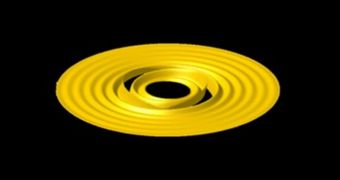One of the largest moons in the solar system may be contributing to keeping one of the dust rings around the gas giant Saturn opened and cracked.
The investigation that led to this conclusion was carried out using the Cassini orbiter, a spacecraft managed by experts at the NASA Jet Propulsion Laboratory (JPL), in Pasadena, California.
Recent studies of the massive ring system surrounding Saturn have revealed that the C ring has a crack in it, which is maintained opened by Titan, one of the most interesting space bodies in the solar system.
According to data from the NASA orbiter, it would appear that the moon's gravity is responsible for lifting part of the aforementioned ring in a rotating tidal wave that is almost two miles high.
“It’s a little bit like a tsunami propagating away from an earthquake fault,” explains Cornell University planetary scientist Phillip Nicholson in an October 4 press briefing.
The findings were presented in Pasadena, California, at the meeting of the American Astronomical Society’s Division for Planetary Sciences, Wired reports.
The new line of study is very important because it may help explain why the ring system surrounding Saturn has so many gaps in it. Some are occupied by moons, but are appear to be free.
Five years ago, Cassini discovered the moon Daphnis in such a fissure, but no new space bodies have been discovered in similar structures ever since. So experts want to know what is causing them.
“It’s become an increasing problem, as to what determines where these gaps are in the rings and what keeps the gaps open,” Nicholson reveals.
“Mostly the rings are very flat. It’s the most two-dimensional structure we know in the Universe. But there are exceptions to every rule, and there are exceptions to the rule that Saturn’s rings are flat everywhere,” he goes on to say.
The researcher explains that the reason why Titan causes these effects is because it orbits the planet at a slight angle. This means that, at one point in its orbit, it will interact with the ring planes at an angle.
“The whole pattern rotates around at the same rate as the satellite Titan orbits Saturn, once every 16 days,” Nicholson reveals.
“This and some other work suggests there might not be one explanation for gaps, there may be three or four or even more different dynamical circumstances that can give rise to these gaps,” he concludes.

 14 DAY TRIAL //
14 DAY TRIAL //